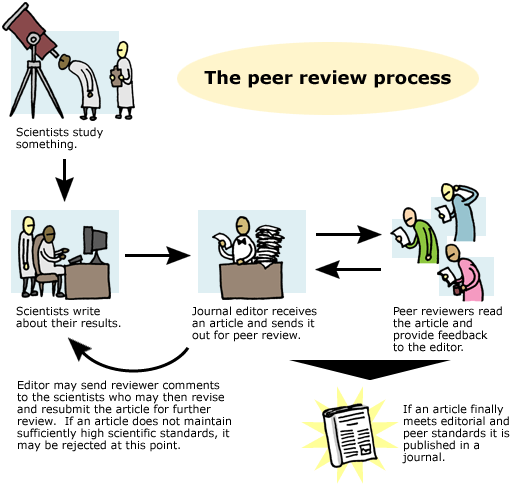Peer review does the same thing for science that the "inspected by #7" sticker does for your t-shirt: provides assurance that someone who knows what they're doing has double-checked it. In science, peer review typically works something like this:
- A group of scientists completes a study and writes it up in the form of an article. They submit it to a journal for publication.
- The journal's editors send the article to several other scientists who work in the same field (i.e., the "peers" of peer review).
- Those reviewers provide feedback on the article and tell the editor whether or not they think the study is of high enough quality to be published.
- The authors may then revise their article and resubmit it for consideration.
- Only articles that meet good scientific standards (e.g., acknowledge and build upon other work in the field, rely on logical reasoning and well-designed studies, back up claims with evidence, etc.) are accepted for publication.

Peer review and publication are time-consuming, frequently involving more than a year between submission and publication. The process is also highly competitive. For example, the highly-regarded journal Science accepts less than 8% of the articles it receives, and The New England Journal of Medicine publishes just 6% of its submissions.
Peer-reviewed articles provide a trusted form of scientific communication. Even if you are unfamiliar with the topic or the scientists who authored a particular study, you can trust peer-reviewed work to meet certain standards of scientific quality. Since scientific knowledge is cumulative and builds on itself, this trust is particularly important. No scientist would want to base their own work on someone else's unreliable study! Peer-reviewed work isn't necessarily correct or conclusive, but it does meet the standards of science. And that means that once a piece of scientific research passes through peer review and is published, science must deal with it somehow — perhaps by incorporating it into the established body of scientific knowledge, building on it further, figuring out why it is wrong, or trying to replicate its results.
PEER REVIEW: NOT JUST SCIENCE
Many fields outside of science use peer review to ensure quality. Philosophy journals, for example, make publication decisions based on the reviews of other philosophers, and the same is true of scholarly journals on topics as diverse as law, art, and ethics. Even those outside the research community often use some form of peer review. Figure-skating championships may be judged by former skaters and coaches. Wine-makers may help evaluate wine in competitions. Artists may help judge art contests. So while peer review is a hallmark of science, it is not unique to science.